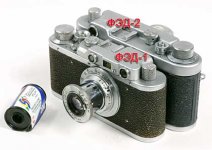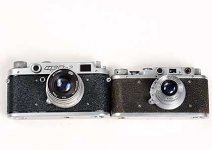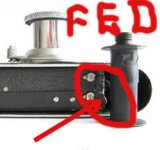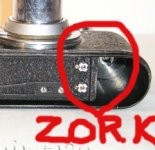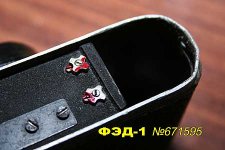manfromh
I'm not there
Does anyone use a Fed-1 as a carry-along camera? Im looking for a compact camera to take with me sometimes. And are there any diferences between older (1b 1935-....) and newer (1g and other) models? I think i have a chance getting one cheaply.
Ash
Selflessly Self-involved
go for a Fed-2... coupled rangefinder, wide base, loading is easy, not so many slow speeds.
i use one as a carry-along usually, just uploaded a few photo's from venice if you need convincing
i use one as a carry-along usually, just uploaded a few photo's from venice if you need convincing
manfromh
I'm not there
How big is the size difference between Fed-1 and 2? Its sounds good, but im not sure if i can find one.
oscroft
Veteran
Apparently many of the earlier ones had bodies made of thin pressed metal that bend easily, so they're probably worth avoiding. The later ones, like the 1g, are more sturdy.Does anyone use a Fed-1 as a carry-along camera? Im looking for a compact camera to take with me sometimes. And are there any diferences between older (1b 1935-....) and newer (1g and other) models? I think i have a chance getting one cheaply
Valkir1987
Well-known
I don't think they vary much in size. I have a Zorki1 with me in my shoulder bag most of the time. I always use the ever ready case, it is sturdy and makes the camera hold better. (especially when you have big hands).
Another Issue is the weight: Zorki's and Feds are about 20% lighter in weight than Leica. My FED weights about half a kilogramme (0,5kg) I really like to carry them around, especially because its more than pressing a button for each subject.
Another Issue is the weight: Zorki's and Feds are about 20% lighter in weight than Leica. My FED weights about half a kilogramme (0,5kg) I really like to carry them around, especially because its more than pressing a button for each subject.
Last edited:
Xmas
Veteran
If you use the origional ERC you are unlikely to crush one unless your bionic hands need adjusting. They are a lot cheaper than a leica II.
If it is cheap (for a fed 1) and is ok condition snap it up.
You will also need a hood, and it is either buy a leitz hood or clone (not cheap) or get a series adopter for 36mm push on, or make one. You will need a hood even is the lens has not been scratched. A cap is also useful.
You will need scissors to cut the film leader to pre '70 leader, care in loading and dicipline to not set the shutter speed until after winding.
Noel
If it is cheap (for a fed 1) and is ok condition snap it up.
You will also need a hood, and it is either buy a leitz hood or clone (not cheap) or get a series adopter for 36mm push on, or make one. You will need a hood even is the lens has not been scratched. A cap is also useful.
You will need scissors to cut the film leader to pre '70 leader, care in loading and dicipline to not set the shutter speed until after winding.
Noel
P
pshinkaw
Guest
The Fed-2 is very common and much easier to find in good working condition. Physically it's close to an M Leica in size but much lighter. Also, the removeable back makes loading a lot easier and faster.
Just get one of each.
-Paul
Just get one of each.
-Paul
Nickfed
Well-known
manfromh said:Does anyone use a Fed-1 as a carry-along camera? Im looking for a compact camera to take with me sometimes. And are there any diferences between older (1b 1935-....) and newer (1g and other) models? I think i have a chance getting one cheaply.
Pre-war FEDs are not as well made and have lens registration problems. I don't think they are worth consideration as a shooter, just as a collectors' item.
I have a FED-1 and do carry it around. It is not a good idea. When you have them in your hand, there is a big difference between these cameras. This thread may be interesting and shows the relative sizes.
http://www.rangefinderforum.com/forums/showthread.php?t=24576
The advantages of the FED-1 is that is small and elegant, and it has a better rangefinder image.
The FED-2 can be had with the same collapsible lens, most, if not all, have strap lugs and it has flash synch. OK, you don't seriously entertain it as a flash camera, but synch is always a good thing to have.
Loading the FED-1 is not so bad but film issue is still the deal-breaker. The FED-2 does not require scissors for loading, nor pliers to get the cartridge out. So you can leave the Swiss Army knife at home. My FED-1 is a late (number on the back) version. Sometimes the cartridge comes out easily, but it usually doesn't. There is no sign of distortion or abuse, it seems to be a design problem.
I don't think the FED-2 has any real advantage in the viewfinder or rangefinder. You pay a hell of a price to get one window.
FED-2s are cheaper.
oscroft
Veteran
I have the same problem with my late model FED 1g. Its size and feel are wonderful (and made me understand what a "Barnack moment" is), but I usually need pliers to get the film out - having to carry a pair of pliers around cancels out the advantage of it being so small in the first place.My FED-1 is a late (number on the back) version. Sometimes the cartridge comes out easily, but it usually doesn't
I also have a FED 2, and even if it doesn't have the "Wow, that's small and neat" appeal, I think it's a much better general shooter. And as you say, they're cheap (I think I paid around £30 for mine inc postage from a trusted dealer - I've seen them go for half that on eBay).
manfromh
I'm not there
I could get Fed-1 in good shape for about $17. Only if the seller still has it though. For a Fed-2, i would have to start searching in antique stores to find one working and cheaply. Though i think i saw one yesterday, when i was on the hunt for a Zorki-3 (i found a broken one). I also saw a Fed-3 and a Zorki-5/6. Lots of other FSU cameras too, but i didnt pay attention to them.
ZorkiKat
ЗоркийК&
A prewar FED-1 can be a good user camera. Stick with its original lens. There are a lot of indications (despite the fact that 50/2, 100, and 28 -mm lenses were made for them) the lens wasn't meant to be replaced or even removed. Unless the body/lens mount flange/ supplementary lens were adjusted first for compatibility. Lenses from different prewar FED-1 won't even likely replace each other.
The uncoated I-10 (FED-50) is quite good. The trouble you'll likely encounter with it is finding out its real back focus/ working distance length. They varied and the camera body has to be adjusted for it. If the prewar FED you get hasn't been tampered with and has its original lens, it should be a good user camera.
Many of the early FED had "soft" bodies, but not really that soft. Early Zorki had even softer bodies. I have several FED-1 from the 1935-38 range, and I could say that none of these have bodies as soft as the early Zorki. Their bodies are about as pliable as the shells of later FED-1(g).
Early FED-1, up to the immediate post-war productions tend to be better made (less 'play' in the moving parts and knobs) than the later FED-1. The only 'bad' with them is the non-standard lens mount threads and lens working distances.
If you can get the FED-1 for $17, go for it. That's a small price to wager.
See http://jay.fedka.com for more about FED-1 and Zorki-1.
Jay
The uncoated I-10 (FED-50) is quite good. The trouble you'll likely encounter with it is finding out its real back focus/ working distance length. They varied and the camera body has to be adjusted for it. If the prewar FED you get hasn't been tampered with and has its original lens, it should be a good user camera.
Many of the early FED had "soft" bodies, but not really that soft. Early Zorki had even softer bodies. I have several FED-1 from the 1935-38 range, and I could say that none of these have bodies as soft as the early Zorki. Their bodies are about as pliable as the shells of later FED-1(g).
Early FED-1, up to the immediate post-war productions tend to be better made (less 'play' in the moving parts and knobs) than the later FED-1. The only 'bad' with them is the non-standard lens mount threads and lens working distances.
If you can get the FED-1 for $17, go for it. That's a small price to wager.
See http://jay.fedka.com for more about FED-1 and Zorki-1.
Jay
manfromh
I'm not there
ZorkiKat said:A prewar FED-1 can be a good user camera. Stick with its original lens. There are a lot of indications (despite the fact that 50/2, 100, and 28 -mm lenses were made for them) the lens wasn't meant to be replaced or even removed. Unless the body/lens mount flange/ supplementary lens were adjusted first for compatibility. Lenses from different prewar FED-1 won't even likely replace each other.
Is it the same on the Fed-1's that were made after the war?
ZorkiKat
ЗоркийК&
manfromh said:Is it the same on the Fed-1's that were made after the war?
Yes, on those made immediately after WWII. I've got two post war FED (ca.1948?) whose lenses have a different RF cam pitch. When these FED's RF are adjusted for their lenses, these cameras won't be able to focus (through RF)
right with other LTM, including later Soviet ones. Their instruction booklets too, say that the lens shouldn't be removed, reason being to avoid damage to the RF sensor, as if the cameras were built like fixed-lens RF cameras.
Why this was so isn't quite clear. Perhaps FED just went on producing cameras patterned after the Leica with no control on lens cross compatibility. Or perhaps the lenses were detachable for use as printing lenses on enlargers, like in the case of Chajka half-frame cameras.
There was no mention of other lenses in these old FED instruction manuals, unlike the manuals for the Zorki. Other lenses (like the 50/2 or 50/1,5) were mentioned as alternatives to the 50/3,5 which came as standard-issues for these cameras.
The situation is different for the later FED. In fact, I've found that the later FED-1 are easiest to use with Leitz and Canon lenses (except those with tongue-shaped coupling cams). Early FED and Zorki (and many later ones) have lens mounts whose grooves had non-standard entry points- lenses could stop anywhere, and often the index marks which are supposed to be seen from the top end somewhere to the side, or at the bottom. Later FED often had these lenses mount properly.
One way to tell which FED-1 does which is by the engravings they have on the top plate. The engraving styles changed during the camera's production life.
See http://fedka.com/Useful_info/Documents_by_Fricke/fed_engr_types.jpg
and
http://fedka.com/Frames/Main_Frame.htm
for a description of these engraving styles.
The serial numbers also help. FED-1 with serial numbers above 45x xxx often are "standard" and have no problems with other FSU or Leitz lenses.
See attachement below to see size differences between FED-1 and FED-2
Jay
Attachments
ZorkiKat
ЗоркийК&
oscroft said:I have the same problem with my late model FED 1g. Its size and feel are wonderful (and made me understand what a "Barnack moment" is), but I usually need pliers to get the film out - having to carry a pair of pliers around cancels out the advantage of it being so small in the first place.
I also have a FED 2, and even if it doesn't have the "Wow, that's small and neat" appeal, I think it's a much better general shooter. And as you say, they're cheap (I think I paid around £30 for mine inc postage from a trusted dealer - I've seen them go for half that on eBay).
It's a production quality control problem. I've one FED 1g which behaves exactly that way. The film chamber is so snug that cassettes are hard to remove. This is probably the reason why this FED 1g looks so minty- it never got to be used much.
This isn't really so with the later FED. I have perhaps a dozen other FED 1g where film casettes slide in and out easily. The film chamber's tightness is due to having the shutter crate laid out a bit erratically. Filing the inner walls which surround the film chamber can cure this- but this isn't a guarantee since too much filing can thin the walls out and cause them to "soften".
The cameras which really have a tight film chamber are the early Zorki-1. These are the same as the "FED-Zorki" but simply engraved as Zorki. These Zorki are exactly FED in the inside (same parts, same round pressure plate, same tiny teardrop-shape RF sensor). Most factory loaded cassettes from Kodak or Fuji will have a tight fit. The shutter crate's wall which is right next to the film chamber isn't flat- it's shaped in such a way that it would catch on the cassette's crimped caps.
Jay
manfromh
I'm not there
The Fed-2 doesnt seem much bigger. If i dont hear from the seller soon then ill try to find one of those instead. Thanks!
Nickfed
Well-known
oscroft said:I have the same problem with my late model FED 1g. Its size and feel are wonderful (and made me understand what a "Barnack moment" is), but I usually need pliers to get the film out - having to carry a pair of pliers around cancels out the advantage of it being so small in the first place.
QUOTE]
Indeed. As I said, there seems to be a design issue. There is a little tongue on the base plate of the shutter crate that seems to serve no purpose other than to foul the cartridge. It is conspicuously absent on the Zorki-1. Perhaps they learned something in the technology transfer. This, and the better placed "B" for the rewind lever, seem to be the fundamental design differences between FED and Zorki!
Attachments
oscroft
Veteran
Oh, that's interesting - I'd never noticed it. Something I have noticed about my Fed 1 is that along the seam of the case, where it's presumably welded, the metal is much thicker than the rest of the case and flat on the inside, and this helps to wedge the cassette in too. I think I might spend a weekend with a hacksaw and file fairly soon.There is a little tongue on the base plate of the shutter crate that seems to serve no purpose other than to foul the cartridge
ZorkiKat
ЗоркийК&
Nickfed said:Indeed. As I said, there seems to be a design issue. There is a little tongue on the base plate of the shutter crate that seems to serve no purpose other than to foul the cartridge. It is conspicuously absent on the Zorki-1. Perhaps they learned something in the technology transfer. This, and the better placed "B" for the rewind lever, seem to be the fundamental design differences between FED and Zorki!
That tongue alone won't cause the cassettes to get stuck. This tounge likely served some purpose- it must have been put there for some type of Leitz type lipless cassette (whose film gate is opened by the turn of the locking ring) which FED may or may not have made. This sort of cassette will thus be prevented from bobbing down and cause the film to go down with it, causing part of the picture to expose on the film perforations.
FED-1 retained the three-piece shutter construction (and other design details) till the last of its production. This had bumps on its wall facing the film chamber. This, along with a tight film chamber can detain a film cassette. Zorki on the other hand changed to a single cast shutter crate early in its production; their shutter crates were also less bumpy on the film chamber side.
I've never had "tight" FED-1 except for one FED-1(g) whose picture is below. It was always the earlier Zorki (serial numbers above 115XXX) which I found to have tight film chambers. Finding this on some later FED-1 means that it is indeed a quality control issue. My early FED-1 always let film cassettes go in and out easily.
The tongue can be filed down (see picture below) without compromising the base plate's lock. I thought that it was the reason why the film cassettes got stuck. But filing just this part did not improve the situation.
The shutter crate wall and part of the body shell surrounding the film chamber have to be lightly filed as well.
Attachments
oscroft
Veteran
That's very helpful, thanks - as soon as I've got a free weekend I'll get out my screwdrivers and files.The tongue can be filed down (see picture below) without compromising the base plate's lock. I thought that it was the reason why the film cassettes got stuck. But filing just this part did not improve the situation. The shutter crate wall and part of the body shell surrounding the film chamber have to be lightly filed as well.
Nickfed
Well-known
oscroft said:That's very helpful, thanks - as soon as I've got a free weekend I'll get out my screwdrivers and files.
I was wondering if it had something to do with Leica type cassettes, but was surprised that Zorki doesn't do it. I still think it's a good idea to get rid of it. I think you should drop the outer body off before attacking it though. Info here if you are not familiar with this: http://rick_oleson.tripod.com/index-101.html
It will be quick, and easier to keep things clean.
I get the impression that the cassette lip can foul behind this tongue, but I guess it isn't the whole problem since it often requires a gentle push all the way when loading.
Share:
-
This site uses cookies to help personalise content, tailor your experience and to keep you logged in if you register.
By continuing to use this site, you are consenting to our use of cookies.

